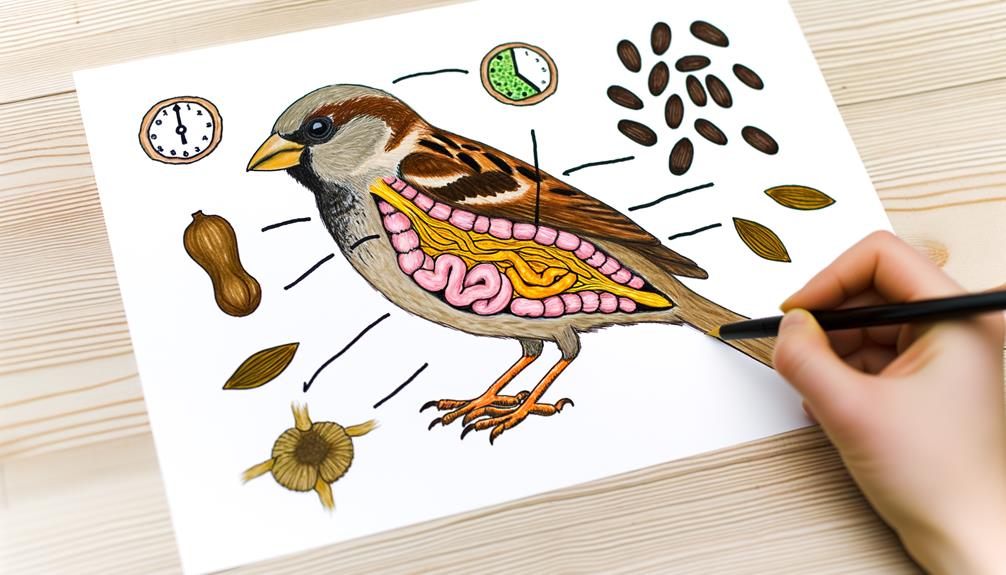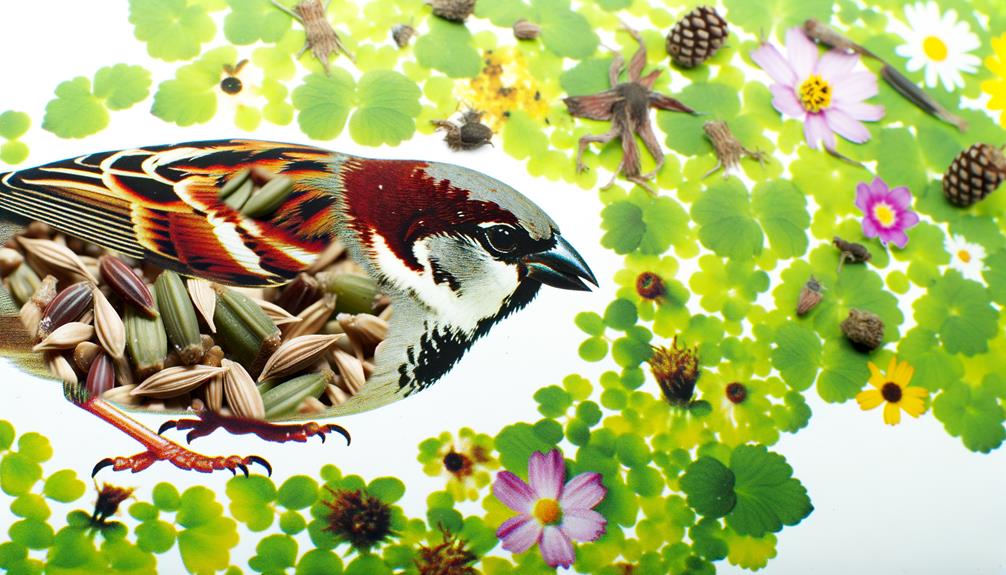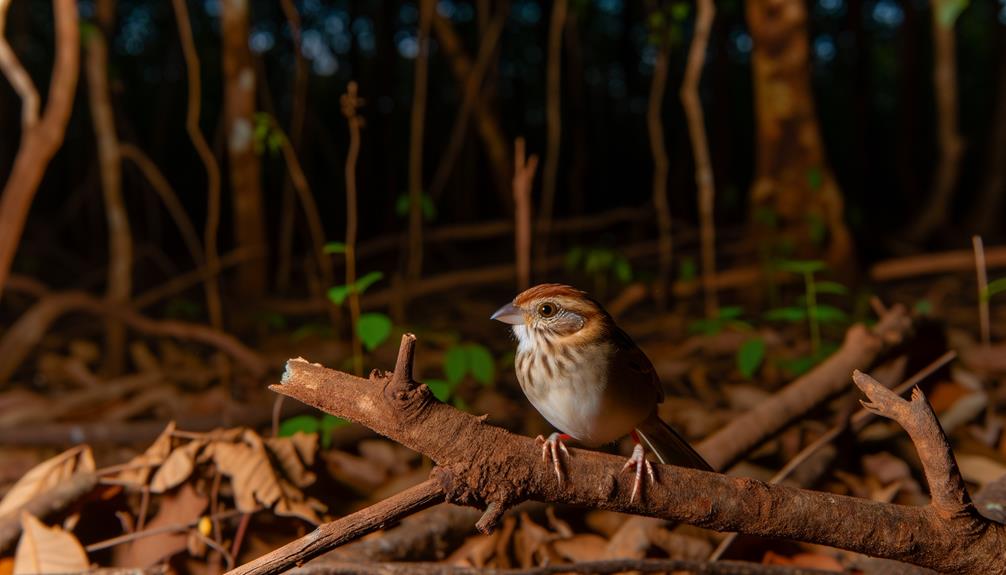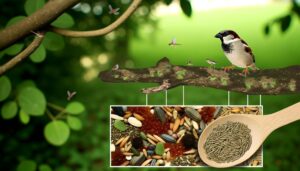How Long Can a Sparrow Go Without Food – A Care Guide
Sparrows possess a high basal metabolic rate, necessitating a daily intake of 30-35 calories to sustain functions like thermoregulation, activity, and reproduction. Their diet mostly includes seeds, insects, fruits, and grains, which supply the essential carbohydrates, proteins, and fats.
In adverse conditions, sparrows can endure fasting for up to 48 hours by relying on energy reserves and adaptive survival strategies such as metabolic rate adjustments and reduced activity. These small birds employ various behavioral and physiological mechanisms to enhance their survival, particularly in fluctuating environmental conditions.
For a more in-depth understanding, continue exploring their intriguing adaptation tactics.

Key Takeaways
- Sparrows can endure fasting for up to 48 hours.
- They rely on fat reserves to sustain energy during food scarcity.
- Behavioral adaptations minimize energy expenditure when food is unavailable.
- Metabolic adjustments help conserve energy during fasting periods.
- Environmental factors and basal metabolic rate influence their fasting tolerance.
Sparrow Metabolism

Sparrows possess a high basal metabolic rate, which necessitates frequent feeding to sustain their energy levels. This elevated metabolic rate is characterized by rapid respiration and heart rates, underlying the species' physiological demands.
Metabolic rate in sparrows is influenced by factors such as ambient temperature, activity level, and body mass. Thermoregulation is a critical aspect of their metabolism, requiring substantial caloric intake to maintain homeostasis, particularly in colder climates. The small size of sparrows contributes to a higher surface area-to-volume ratio, exacerbating heat loss and thereby increasing metabolic demands.
Consequently, sparrows must consume nutrient-rich food sources frequently to meet their metabolic requirements, highlighting the intricate balance between energy intake and expenditure in these avian species.
Daily Energy Needs
The daily energy needs of sparrows are determined by their high metabolic rates, requiring regular and substantial caloric intake to sustain physiological functions and activity levels. These small avians need approximately 30-35 calories per day, obtained from a mix of carbohydrates, proteins, and fats. The high energy demand is essential for maintaining thermoregulation, foraging efficiency, and reproductive activities.
| Factor | Energy Requirement | Example Activities |
|---|---|---|
| Basal Metabolic Rate (BMR) | 50-60% | Resting, basic body functions |
| Thermoregulation | 20-25% | Maintaining body temperature |
| Physical Activity | 10-20% | Flight, foraging, nest building |
| Reproduction | 5-10% | Egg production, courtship |
Understanding these factors enables a thorough understanding of the sparrow's dietary imperatives and survival strategies.
Typical Diet

An elaborate balance of seeds, bugs, fruits, and grains forms the typical diet of sparrows, providing the necessary nutrients to fuel their active lifestyles.
These avian foragers display a noticeable preference for small seeds from grasses and weeds, which supply crucial carbohydrates.
Insects and other arthropods, consumed mainly during the breeding season, offer a rich source of proteins and fats essential for chick development and adult maintenance.
Fruits, although less frequently consumed, contribute vitamins and antioxidants that enhance avian health.
Additionally, grains from agricultural fields are opportunistically utilized, increasing their dietary variety.
This dietary composition guarantees sparrows meet their metabolic demands, supporting their high-energy behaviors such as flight, foraging, and reproduction.
Fasting Tolerance
Fasting tolerance in sparrows is intricately linked to their basal metabolic rate and the efficiency of their energy reserves. Environmental factors such as ambient temperature and food availability further modulate their ability to endure periods without nourishment.
Additionally, sparrows employ various physiological and behavioral survival strategies to mitigate the effects of food scarcity.
Metabolism and Energy Reserves
Sparrows display remarkable metabolic efficiency, enabling them to optimize energy reserves during periods of food scarcity. Their basal metabolic rate (BMR) is finely tuned to balance energy intake with expenditure, maximizing survival.
Glycogen stores in the liver and muscles provide short-term energy, while adipose tissue reserves offer a more sustainable source during prolonged fasting. These birds can adjust their metabolic rate to conserve energy, entering a state of torpor to minimize caloric expenditure.
In this case, the regulation of insulin and glucagon facilitates the efficient mobilization of glycogen and lipid reserves. Consequently, sparrows can endure fasting for up to 48 hours, although this tolerance varies based on individual health and prior nutritional status.
Environmental Influences
Environmental conditions, such as ambient temperature, food availability, and predation pressure, greatly influence the fasting tolerance of sparrows. Sparrows in colder climates expend more energy to maintain body temperature, reducing fasting tolerance. Conversely, those in warmer regions may endure longer fasting periods. Food availability directly correlates with energy reserves, influencing survival duration without nourishment. Predation pressure compels sparrows to prioritize immediate food consumption over storing energy reserves, impacting fasting capacity.
| Environmental Factor | Impact on Fasting Tolerance |
|---|---|
| Ambient Temperature | Higher energy expenditure in cold |
| Food Availability | Direct correlation with reserves |
| Predation Pressure | Reduces energy storage capability |
| Geographic Location | Varies energy expenditure needs |
| Seasonal Changes | Affects food supply consistency |
These factors collectively determine sparrows' resilience during food scarcity.
Survival Strategies
Understanding the interplay between environmental factors and sparrows' physiological adaptations is crucial to comprehending their fasting tolerance and survival strategies. Sparrows exhibit remarkable metabolic flexibility, enabling them to endure periods of food scarcity. Their basal metabolic rate (BMR) can be adjusted to conserve energy, reducing caloric expenditure during fasting.
Additionally, sparrows possess an ability to mobilize fat reserves and catabolize muscle protein, sustaining essential physiological functions. Environmental variables, such as ambient temperature and food availability, further influence these adaptations. In colder climates, enhanced thermogenic capacity aids in maintaining homeostasis, while in temperate regions, behavioral strategies like food caching become essential.
Collectively, these mechanisms underscore the sparrow's resilience, optimizing survival in fluctuating conditions.
Survival Mechanisms

Sparrows employ several survival mechanisms during periods of food scarcity. These include metabolic rate adaptations that minimize energy expenditure. They also implement energy conservation strategies like reducing physical activity and lowering body temperature.
Additionally, changes in foraging behavior are critical for sustaining their energy levels. This includes increased efficiency and altered dietary preferences.
Metabolic Rate Adaptations
Adaptive modulation of metabolic rate is a critical survival mechanism that enables sparrows to endure periods of food scarcity. This adaptive response involves the physiological adjustment of basal metabolic rate (BMR) to conserve energy.
Sparrows can exhibit a decrease in BMR by as much as 30-40% during fasting states, which reduces the overall caloric expenditure. This metabolic plasticity is facilitated by hormonal changes, including the downregulation of thyroid hormones such as thyroxine (T4) and triiodothyronine (T3), which play pivotal roles in metabolic regulation.
Additionally, sparrows can alter their thermogenic responses to maintain core body temperature with minimal energy usage. These precise adaptations are essential for extending survival time during periods when food resources are scarce, thereby enhancing their resilience.
Energy Conservation Strategies
In conjunction with metabolic rate adjustments, sparrows employ a suite of energy conservation strategies that are essential to their survival during periods of food deprivation. These strategies play a key role in minimizing energy expenditure while maximizing their chances of survival.
Key techniques include:
- Reduced Activity Levels: Sparrows decrease their movement, conserving energy typically used in flight and foraging.
- Utilizing Shelter: Seeking sheltered locations helps minimize exposure to environmental stressors, reducing thermoregulatory demands.
- Torpor Induction: Entering a state of torpor, sparrows markedly lower their body temperature and metabolic rate, conserving substantial energy.
- Fat Reserves Utilization: Prior accumulation and subsequent mobilization of fat reserves serve as a crucial energy source during food scarcity.
These mechanisms collectively enhance sparrows' resilience to periods of food scarcity.
Foraging Behavior Changes
During periods of food scarcity, significant alterations in foraging behavior are essential for sparrow survival. These adaptive behaviors include increased foraging range, altered diet preferences, and heightened vigilance to optimize energy intake while minimizing risks. Sparrows exhibit a remarkable plasticity in their foraging strategies, reflecting their capacity to exploit diverse food sources and habitats.
| Behavior | Description | Impact on Survival |
|---|---|---|
| Increased Range | Expansion of foraging territory | Access to more food resources |
| Diet Flexibility | Inclusion of less preferred food items | Enhanced nutritional intake |
| Vigilance | Increased alertness to predators | Reduced predation risk |
| Social Foraging | Foraging in groups | Improved food location efficiency |
| Nocturnal Foraging | Foraging during twilight or night | Reduced competition and predation |
These behaviors collectively enhance the sparrow's resilience to environmental pressures.
Fat Reserves
Fat reserves play an essential role in a sparrow's ability to survive periods of food scarcity, providing necessary energy needed to maintain metabolic functions. These energy stores are vital, as a sparrow's high metabolic rate demands continuous fuel.
The physiological significance of fat reserves includes:
- Energy Storage: Fat reserves are metabolized to release energy.
- Thermoregulation: Fat acts as an insulator, helping sparrows maintain body temperature.
- Sustenance During Fasting: Stored fat allows sparrows to endure short-term fasting without immediate detriment.
- Reproductive Health: Adequate fat reserves are necessary for successful breeding and nurturing offspring.
The ability to store and efficiently utilize fat reserves is crucial for a sparrow's survival strategy during periods of food scarcity.
Water Intake

Adequate water intake is important for sparrows, as it supports their high metabolic rate and facilitates necessary physiological processes. Water is essential for thermoregulation, nutrient transport, and waste excretion.
Sparrows typically obtain water from their diet, including seeds and insects, which contain varying water content. Additionally, they drink free-standing water and can utilize dew or rain droplets.
In conditions of limited water availability, sparrows exhibit behavioral adaptations such as reduced activity levels to conserve moisture. Dehydration can severely impair their metabolic functions and ultimately lead to mortality.
Therefore, continuous access to water is a crucial aspect of their survival strategy, particularly in environments where water sources are scarce or subject to seasonal fluctuations.
Weather Impact
Weather conditions greatly influence the survival and behavior of sparrows, impacting their foraging efficiency, thermoregulation, and overall energy expenditure. Adverse weather conditions, such as extreme cold or intense heat, can limit the availability of food and increase the metabolic demands on these small birds.
The following factors demonstrate the profound impact of weather:
- Cold Weather: Sparrows require more energy to maintain body heat, leading to increased food consumption.
- Heat Waves: High temperatures can reduce insect activity, an essential food source, and increase dehydration risks.
- Rainfall: Heavy rainfall can impede foraging activities, causing food scarcity.
- Wind: Strong winds can disrupt flight and foraging efficiency, leading to higher energy expenditure.
Understanding these factors is essential for comprehending sparrow ecology.
Predation Risks

In addition to weather conditions, predation risks greatly affect sparrow survival and foraging behavior. Predators such as hawks, cats, and snakes impose significant threats, particularly during vulnerable times like feeding.
Sparrow vigilance is heightened in open areas with less cover, altering their foraging patterns. Studies indicate that increased predation pressure reduces feeding times and necessitates frequent escapes, subsequently affecting their energy reserves.
Predation risk also influences habitat selection, with sparrows favoring environments where they can quickly seek refuge. This constant threat compels sparrows to prioritize safety over foraging efficiency, thereby reducing their food intake and accelerating starvation risks.
Understanding these dynamics is vital for comprehending how predation pressures contribute to the overall survival challenges faced by sparrows.
Human Influence
Human activities profoundly impact sparrow populations by altering their habitats, food availability, and exposure to pollutants. Urbanization leads to habitat fragmentation, reducing nesting sites and foraging areas.
The use of pesticides in agriculture diminishes insect populations, a primary food source for sparrows. Pollution from industrial and vehicular emissions contaminates their food and water. These anthropogenic factors result in:
- Habitat Loss: Urban sprawl destroys natural habitats, leaving sparrows without shelter.
- Food Scarcity: Pesticides and monocultures reduce the diversity and availability of food.
- Toxic Exposure: Pollutants accumulate in the ecosystem, poisoning sparrows.
- Climate Disruption: Human-induced climate change alters migration patterns and seasonal behaviors.
Understanding these impacts is essential for developing conservation strategies to protect sparrow populations.
Seasonal Changes

Adapting to seasonal changes, sparrows exhibit distinct behavioral and physiological modifications to cope with fluctuations in temperature and food availability. Their metabolic rate adjusts to conserve energy during colder months, while their plumage thickens to provide better insulation. Additionally, sparrows alter their foraging patterns, increasing their food intake to build fat reserves pre-winter and shifting to different food sources as seasons change.
| Season | Behavioral Adaptations |
|---|---|
| Winter | Increased food intake, fat accumulation |
| Spring | Enhanced foraging, nesting behavior |
| Summer | Exploration of varied food sources |
These adaptations are essential for sparrows' survival, as they secure energy efficiency and optimize resource utilization, thereby minimizing the risk of starvation during periods of scarcity.
Observation Tips
Accurate observation of sparrows necessitates an understanding of their distinct behavioral patterns and ecological preferences throughout different seasons. Here are key tips to ensure precise monitoring:
- Seasonal Behavior: In winter, sparrows exhibit flocking behavior for warmth and protection, while in summer, they display more solitary or pair-bonded activities.
- Feeding Habits: Note that sparrows adjust their diet based on food availability; in spring, they consume more insects, whereas in autumn, seeds become predominant.
- Habitat Preferences: Sparrows prefer dense shrubs and urban areas for nesting; observing these locales can yield richer data.
- Activity Timing: Early morning and late afternoon are peak periods for sparrow activity, making these times ideal for observation.
Understanding these factors can greatly enhance the accuracy and depth of sparrow studies.
Conclusion
To sum up, sparrows exhibit a high metabolic rate necessitating frequent food intake to sustain daily energy demands. Typical diets, consisting primarily of seeds and insects, provide essential nutrients.
Fasting tolerance varies, though most cannot endure more than 48 hours without sustenance. Adaptive survival mechanisms, including fat reserves and altered activity levels, mitigate food scarcity impacts.
Predation, human activity, and seasonal changes further influence their fasting endurance, underscoring the intricate balance within avian ecology. Observational data remain essential for a thorough understanding.






